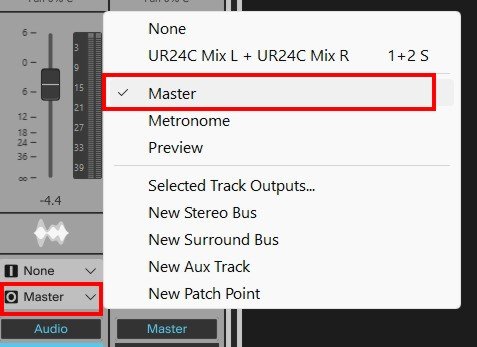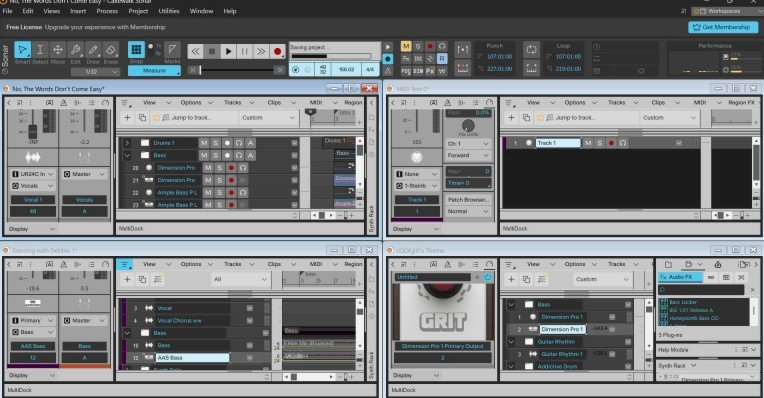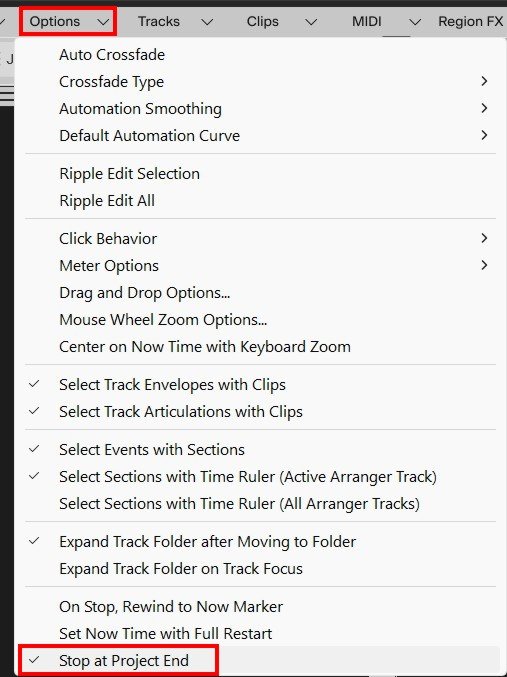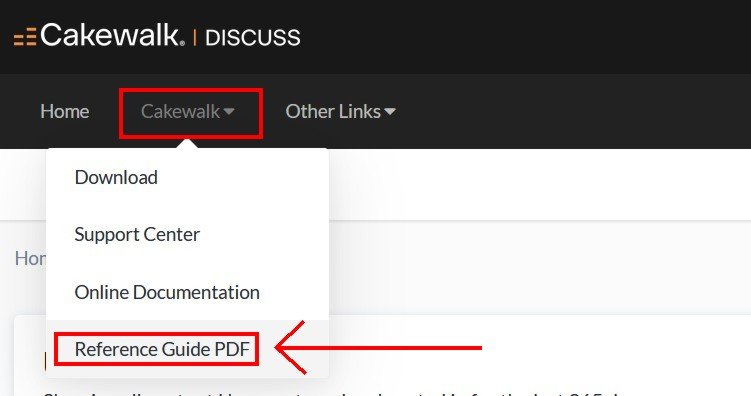-
Posts
620 -
Joined
-
Last visited
Everything posted by Chaps
-

Using Sonar for recording and playback
Chaps replied to Forlænget Spilletid's topic in Cakewalk Sonar
Okay. Good luck. -

Using Sonar for recording and playback
Chaps replied to Forlænget Spilletid's topic in Cakewalk Sonar
I'm pretty sure it isn't. One problem you will have in seeking help here is your unfamiliarity with the specific terms used to describe Cakewalk elements, tools, and processes. I strongly urge you to use the Cakewalk Product Manager to download and install the local Cakewalk Sonar Local Help so you can access the Help files from within Sonar. Or, to download the Cakewalk Sonar Reference Guide as PDF from the top menu under Cakewalk https://bandlab.github.io/cakewalk/docs/Cakewalk Sonar Reference Guide.pdf . It is an invaluable aid for all users. I keep it on my desktop for easy reference. The outputs of all audio tracks can be directed to a Bus, acting as a master volume control, before reaching the output device. You can output the audio track to a master bus, or another bus that is output to the master bus. You may or may not have a Master Bus depending on how you created your project. If you have a master bus it will be shown as an option in the output section at the bottom of an audio track. See first image below to see an example of this. If you do not have a master bus you can create one by right clicking in the bus pane to create a New Stereo Bus. It is common practice to create other buses, like one for guitar or one for bass, and output those to the master bus. To show/hide the bus pane click the two little arrows pointing at each other at the bottom of the track view. See second image. I strongly urge you to look for videos on YouTube on how to use Cakewalk software. All the versions in the last few years are fundamentally the same when it comes to setting up and recording. We can just keep throwing terms at you that you are unfamiliar which may not be very useful to you so it might be helpful to watch videos that go through different processes, like setting up the program and recording audio. -

Using Sonar for recording and playback
Chaps replied to Forlænget Spilletid's topic in Cakewalk Sonar
Are your audio tracks being output to the Master bus or straight to the Hardware Outputs? -

VST Plugins That Have General MIDI 2 Sound Sets?
Chaps replied to Annabelle's topic in Cakewalk by BandLab
I still have my old Boss DS-330 Dr. Synth module, though I only keep it handy in case I ever start using my MIDI controller to record with Sonar. Same way I use my Digitech RP350 to monitor sounds live while I record my guitar's signal through a direct box. This is why latency is never an issue with me. -

Sonar asking for Sign-in, but Sign-in is timing out
Chaps replied to Steve Moddelmog's topic in Cakewalk Sonar
Update: I just successfully signed in to BandLab from Sonar free and also at the BandLab website. -

Sonar asking for Sign-in, but Sign-in is timing out
Chaps replied to Steve Moddelmog's topic in Cakewalk Sonar
Yeah, that's what I would do if I had a BandLab subscription. -

Sonar asking for Sign-in, but Sign-in is timing out
Chaps replied to Steve Moddelmog's topic in Cakewalk Sonar
That might be hard to do if the BandLab site can't be accessed. -

Sonar asking for Sign-in, but Sign-in is timing out
Chaps replied to Steve Moddelmog's topic in Cakewalk Sonar
If it were me I would delete the Bandlab cookies and clear the cache in the browser I use to authenticate Sonar and then try to open Sonar again. Can't hurt to try. -

Sonar asking for Sign-in, but Sign-in is timing out
Chaps replied to Steve Moddelmog's topic in Cakewalk Sonar
I can't log in to Bandlab either but I opened a project in Sonar free and it seems unaffected by the fail log in. -
All the FX will affect what you hear but are not recorded with the audio, as far as I know . If you want the FX to be added permanently to the recorded audio you can select the track/clip and in the top menu click Process>Apply Effect>Audio Effects. This will write the FX to the selected audio and, if you want, remove the FX from the FX bin. Or you can bounce the track to a new track and then you can delete or archive the original audio. Not writing the FX to a track while recording is. IMO, a much more flexible option than recording the FX as you record.
-
The Windows options at the top are Cascade, Tile in Rows, Tile in Columns, and Arrange Icons (Not sure what that one does). Here is what my Sonar looks like with the Tile in Rows option. As you can see there are four different projects open at the same time. You should explore those options.
-
I'm using the Free Sonar and as a test I have four projects loaded right now, so I'm not sure what problem you're having there. Are you clicking Window at the top to see the projects that are loaded?
-

Can't see figures (pictures) in Cakewalk Documentation
Chaps replied to LNovik@aol.com's topic in Cakewalk Sonar
I've installed it from the Product Center multiple times in the past and it has never worked for me. This time I opened the Installer Location and ran the installer manually. Now it works. -

Can't see figures (pictures) in Cakewalk Documentation
Chaps replied to LNovik@aol.com's topic in Cakewalk Sonar
That has never worked for me. Is there a specific location the reference guide PDF has to be in for that to work? -
The Yamaha Steinberg USB Driver is the one you want to keep. It is the driver listed in your interface's documentation as the one to use. If you don't want to fiddle with your Window's registry I suggest using Revo Uninstaller to remove the Steinberg Low Latency and Realtek ASIO drivers. I've been using the free version for years and it works great and is very thorough. I also suggest downloading and installing TOOLS_for_CI2_V199 (probably the 64 bit version) after you have removed the other two drivers.As long as the Steinberg low latency and Realtek ASIO drivers are in your system you will have problems running Cakewalk. It's a quirk of Cakewalk software that it is very picky when it comes to ASIO drivers. No one likes it but it is what it is. TOOLS_for_CI2_V199 Revo Uninstaller
-
You can resize modules by right-clicking blank space in the control bar. Right-clicking in the blank space to the left of a module, generally, will have also have the option of modifying the size of that module. My own preference, since they can take up so much screen space, is to have the fewest number of modules showing and in large size. It will take some experimenting to find what works best for you. Here is an image of the menu that opened when I right-clicked in the black space to the left of the transport module.
-
If you've never used regedit to modify the Windows registry it can be confusing and I am not up to the task of explaining it in a way that guarantees you won't mess it up. I suggest looking online for videos that explain it so you will understand the basics before trying to edit the registry. Here is one video that shows a very simplified version of the process of removing unwanted ASIO drivers. How to delete old ASIO device entries
-
What Audio Interface are you using? If it were me I would suspect that there was an ASIO driver conflict caused by an ASIO driver that was not compatible with Cakewalk Sonar. I would open the Registry Editor and look at Computer\HKEY_LOCAL_MACHINE\SOFTWARE\ASIO key to see what drivers were installed there. In my case, I have problems when Steinberg software installs the Steinberg Low-Latency driver but my interface only works with the Yamaha Steinberg USB ASIO driver. Deleting any other driver always solves my problem. Anyway, if I had your problem that is the first thing I would look at, to either delete the unwanted driver or to rule it out as the cause of my problem.
-
-
I looked at the My Attachments page in my profile and saw this "You have used 9.86 MB of your 48.83 MB attachment limit" so maybe your problem is related to being close to, or exceeding your maximum limit for attachments.
-
-

Can't import simple wav file into new cakewalk sonar free ver
Chaps replied to LNovik@aol.com's question in Q&A
The best resource for learning Cakewalk Sonar terminology, and what things are and how they work, is the Cakewalk Sonar Reference Guide which can be viewed online or downloaded, from a link at the top of the forum. It is a most valuable aid for Cakewalk users from beginning to advanced. -
Well, I can reproduce it but I don't consider it a problem because I haven't used the TTS-1 for several years. There are so many other options now, many of them free, that the only reason I would need the TTS-1 is if I downloaded a MIDI file from the Internet that I wanted to play, which is also something I haven't done for years.










